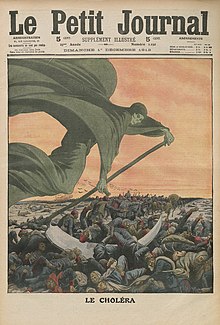ஆறாவது காலரா பெருந்தொற்று
ஆறாவது காலரா பெருந்தொற்று (sixth cholera pandemic) (1899-1923) என்பது இந்தியாவில் தொடங்கி 800,000க்கும் அதிகமான மக்களைக் கொன்று, மத்திய கிழக்கு, வட ஆப்பிரிக்கா, கிழக்கு ஐரோப்பா மற்றும் உருசியாவிற்குப் பரவியது.[1]

வரலாறு
தொகுலியோனார்ட் ரோஜர்ஸின் கூற்றுப்படி, அரித்துவார் கும்பமேளாவில் காலரா பெருந்தொற்று முதலில் தோன்றி தொடர்ந்து, பஞ்சாப், ஆப்கானித்தான், பெர்சியா மற்றும் தெற்கு உருசியா வழியாக ஐரோப்பாவிற்குப் பரவியது.[2][3]
அமெரிக்காவில் கடைசியாகக் காலரா 1910-1911-ல் தோன்றியது. நீராவிக் கப்பல் மோல்ட்கே காலராவால் பாதிக்கப்பட்டவர்களை நாபொலிருந்து நியூயார்க் நகரத்திற்குக் கொண்டு வந்தது. பத்தொன்பதாம் நூற்றாண்டில் தனிமைப்படுத்தப்பட்ட வசதியாகக் கட்டப்பட்ட ஸ்வின்பர்ன் தீவில் பாதிக்கப்பட்டவர்களை விழிப்புடன் சுகாதார அதிகாரிகள் தனிமைப்படுத்தினர். இவர்களுக்கு இந்த தீவு மருத்துவமனையில் சிகிச்சையளித்த சுகாதார ஊழியர் ஒருவர் உட்பட 11 பேர் இறந்தனர்.[4][5][6]
1913ஆம் ஆண்டில், உருமேனியத் தரைப்படை, இரண்டாம் பால்கன் போரின் போது பல்கேரியாவை ஆக்கிரமித்தபோது, காலரா பரவியது. இது 1,600 மேற்பட்ட உயிர் இழப்பினை ஏற்படுத்தியது.[7][8]
மேலும் பார்க்கவும்
தொகு- காலரா வெடிப்புகள் மற்றும் தொற்றுநோய்கள்
மேற்கோள்கள்
தொகு- ↑ . December 2, 2008.
- ↑ R. Dasgupta. "Time Trends of Cholera in India : An Overview" (PDF). INFLIBNET. பார்க்கப்பட்ட நாள் 13 December 2015.
- ↑ Rogers, L. (1926). The Conditions Influencing the Incidence and Spread of Cholera in India. Proceedings of the Royal Society of Medicine, 19(Sect Epidemiol State Med), 59–93.
- ↑ The Boston Medical and Surgical Journal. Massachusetts Medical Society. 1911.
In New York, up to July 22, there were eleven deaths from cholera, one of the victims being an employee at the hospital on Swinburne Island, who had been discharged. The tenth was a lad, seventeen years of age, who had been a steerage passenger on the steamship, Moltke. The plan has been adopted of taking cultures from the intestinal tracts of all persons held under observation at Quarantine, and in this way it was discovered that five of the 500 passengers of the Moltke and Perugia, although in excellent health at the time, were harboring cholera microbes.
- ↑ "Cholera Kills Boy. All Other Suspected Cases Now in Quarantine and Show No Alarming Symptoms.". https://timesmachine.nytimes.com/timesmachine/1911/07/18/104829895.pdf. "The sixth death from cholera since the arrival in this port from Naples of the steamship Moltke, thirteen days ago, occurred yesterday at Swinburne Island. The victim was Francesco Farando, 14 years old."
- ↑ "More Cholera in Port" இம் மூலத்தில் இருந்து 2008-12-16 அன்று. பரணிடப்பட்டது.. https://web.archive.org/web/20081216072507/http://pqasb.pqarchiver.com/washingtonpost_historical/access/250061412.html?dids=250061412%3A250061412&FMT=ABS&FMTS=ABS%3AFT&date=OCT+10%2C+1910&author=&pub=The+Washington+Post&desc=MORE+CHOLERA+IN+PORT&pqatl=google. "A case of cholera developed today in the steerage of the Hamburg-American liner Moltke, which has been detained at quarantine as a possible cholera carrier since Monday last. Dr. A.H. Doty, health officer of the port, reported the case tonight with the additional information that another cholera patient from the Moltke is under treatment at Swinburne Island."
- ↑ Leașu, Florin; Nemeț, Codruța; Borzan, Cristina; Rogozea, Liliana (2015). "A novel method to combat the cholera epidemic among the Romanian Army during the Balkan War - 1913". Acta Medico-Historica Adriatica 13 (1): 159–170. பப்மெட்:26203545. https://www.researchgate.net/publication/281820179.
- ↑ Ciupală, Alin (25 May 2020). "Epidemiile în istorie | O epidemie uitată. Holera, România și al Doilea Război Balcanic din 1913" (in ரோமேனியன்). University of Bucharest.